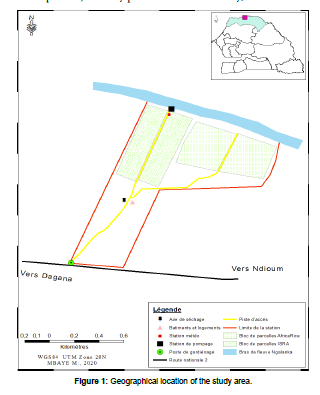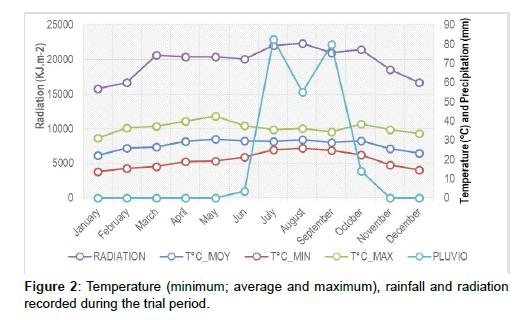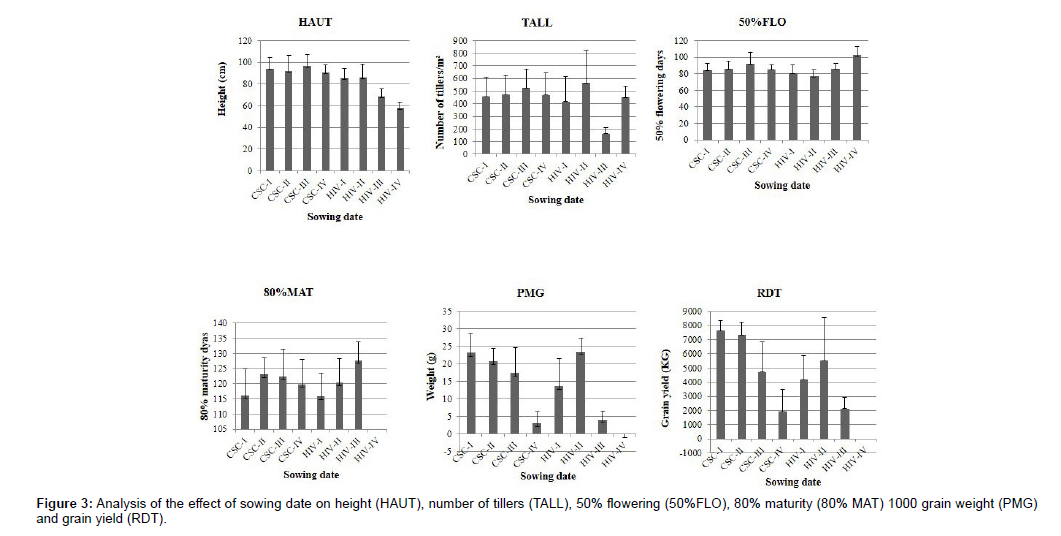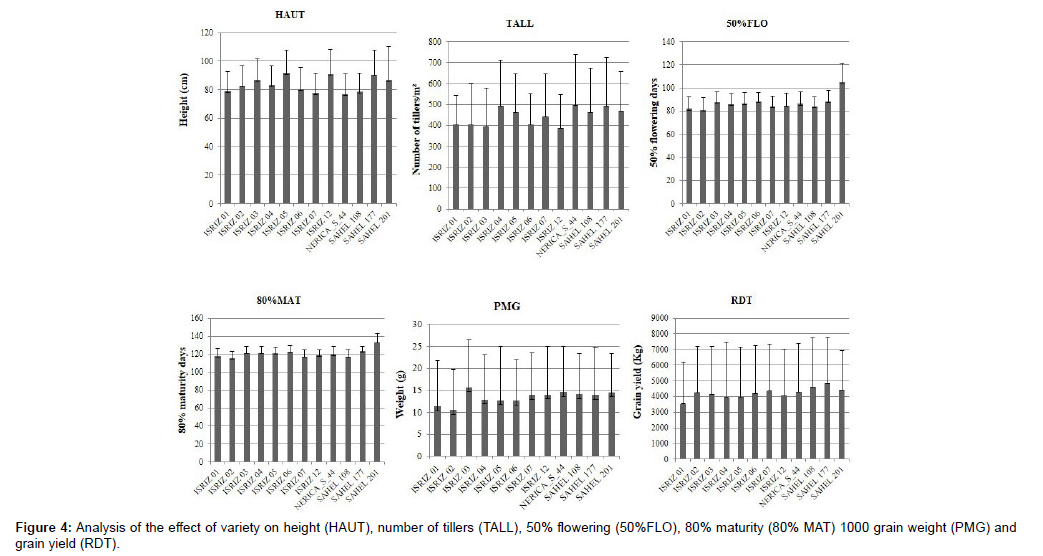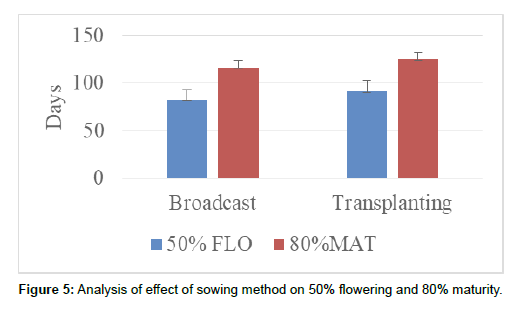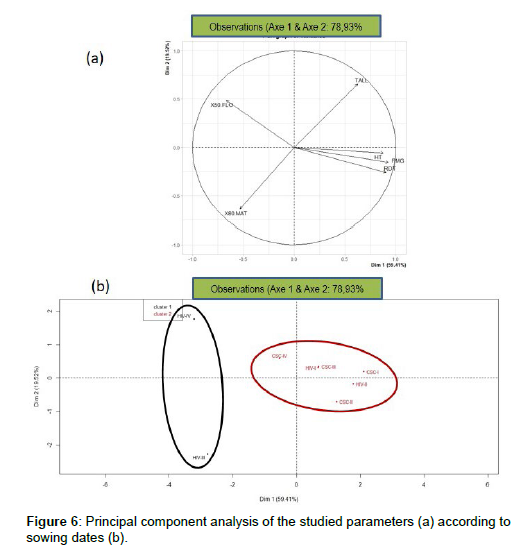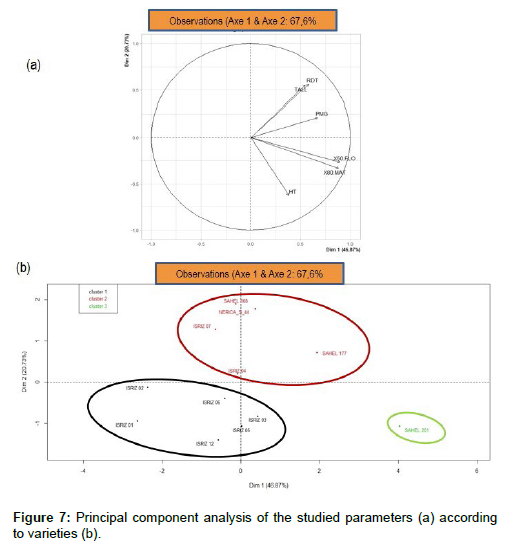Evaluation of the Sensitivity of New Rice Varieties to Temperature According Sowing Dates and Methods in the Senegal River Valley
Received: 28-Oct-2022 / Manuscript No. rroa-22-76117 / Editor assigned: 03-Oct-2022 / PreQC No. rroa-22-76117 / Reviewed: 17-Oct-2022 / QC No. rroa-22-76117 / Revised: 24-Oct-2022 / Manuscript No. rroa-22-76117 / Published Date: 31-Oct-2022 DOI: 10.4172/2375-4338.1000329 QI No. / rroa-22-76117
Abstract
In Senegal, rice is a widely consumed food, making it a strategic product for food security. However, the productivity and yields of traditional local rice varieties face various abiotic constraints, including climatic variability in the Senegal River Valley. A study was conducted over two contrasting seasons with the aim of evaluating the impact of sowing dates,sowing method and temperature variations on the production potential (more than 10t.ha-1) of new rice varieties. A splitsplit plot design was set up with four sowing dates in the warm counter-season (March to May 2020) and in the rainy season (July to September 2020), two sowing modes and eight new rice varieties. The data collected included height,number of tillers, 50% flowering date, 80% maturity date, thousand grain weight and grain yield. The sowing date has an effect on the rice plant mainly by lengthening the production cycle and during low temperatures. Rice reproduction was disrupted, causing spikelet sterility, up to 100% for late winter sowings. Of all the new varieties tested, four achieved good yields estimated at over 8t.ha-1. The analysis of the results showed that the best sowing dates in the off-season and in the winter season were, 04 March and 09 August respectively. The best yield was obtained with direct seeding,although there was no significant difference between the two seeding methods. The results of this study could help improve technical itineraries and rice yields by farmers in the Senegal River Valley.
Keywords: Sensitivity; Temperature; Sowing date; Sowing method;Yield
Keywords
Sensitivity; Temperature; Sowing date; Sowing method; Yield
Introduction
Rice is consumed as a staple food by over two billon people worldwide [1]. In the Sahalien region, rice is a highly prized food and a commercial issue; which makes it a strategic product for food security [2, 3]. Countries in the region face many challenges in increasing agricultural production and ensuring food security. These challenges include the effects of climate variability and change, as well as non-climatic factors such as population growth, soil degradation and declining soil fertility, which are responsible for declining yields [4]. Therefore, feeding such a large population in a context of climate variability becomes a difficult challenge. Rice production is strongly influenced by environmental factors such as photo-periodism, relative humidity and temperature [5]. This has resulted in a 1% decrease in production 2021/2022 [6]. As a result, local production remains limited and thus accentuates imports, which are estimated at nearly 20 million tonnes in 2022, i.e. around 40% of world rice trade to cover the population’s rice needs. In order to reduce imports and address the production deficit by meeting the ever-increasing demand, the West African authorities adopted in 2014, the Regional Rice Offensive to produce 25 million tonnes by 2025 [7,8]. Thus, to meet the everincreasing demand and achieve self-sufficiency in rice, Senegal has focused on intensifying the agricultural sector by re-mobilising stakeholders and making a considerable effort in mechanisation [9]. To this end, areas have been identified according to their potential to contribute to the achievement of national self-sufficiency in rice [10]. The Senegal River Valley, with an estimated hydro-agricultural potential of 240,000 hectares, and the Anambé Basin, with an estimated potential of 12,000 hectares, were chosen because of the possibility of increasing rice yields in these areas through double cropping in the hot off-season and in the winter season [11]. These two areas could provide 60% and 40% of production respectively to meet national demand (FAO, 2014). However, rice cultivation in the Senegal River Valley faces several difficulties, mainly related to the climate, which plays an important role in productivity and the use of traditional varieties that are less suited to climatic requirements. This results in fluctuating productivity [12, 13]. It is therefore necessary to adapt the cropping calendar with the introduction of new varieties that perform better than the old ones and thus facilitate the double cropping of rice (counter-hot season and wintering), which is less and less practiced by producers, who prefer to put their efforts into the counter-hot season.
But in a context of climatic variability, how can a choice of varieties and sowing date contribute to increasing the yield in the off-dry season and help achieve national self-sufficiency in rice?
Two hypotheses emerge from this question:
(i) Climatic variability related to the sowing date has an effect on rice production; and
(ii) The choice of high-yielding varieties can stabilise or even increase rice production, but also facilitate double cropping.
To validate these hypotheses, this study was ignited with the main objective of proposing a new cropping schedule. Specifically, the aim is to determine the varieties that are best adapted to these sowing periods.
Materials and Methods
Study area
The study was conducted at the Experimental Station of the Agricultural Research Centre of the Senegalese Institute of Agricultural Research in Fanaye (16°33 N et 15°46 W), (Figure 1)
Soil characteristics
The soil profile at Fanaye is of the Vertisol type. The test soil is characterised by a content of at least 6.5 mg C Kg-1 soil and mg P Kg-1 (P-Bray1) [14]. In fact, three types of soil can be distinguished at the Fanaye station:
- Hollaldé: characterised by a high clay content of between 50 and 75% (clay soils).
- Faux hollaldé: characterised by a clay content of between 30 and 50% (clay-silt soils).
- Fondé: salty soil characterised by a low clay content of 10 to 30%.
Evolution of climatic parameters during the experiment
Low temperatures were recorded in January-March 2020 on one hand and in November-December 2020 on the other. From March onward, the minimum temperature increased gradually, peaking in July-August (around 26°C), before dropping to 14°C in December. The maximum temperature peaked in May (42°C). The average temperature varied between 22°C and 30°C during 2020. Rainfall was almost nil for most of the year. The annual rainfall recorded was 72 mm between July and September; the rainy period for the area. Finally, radiation from January to Decmeber 2020 ranged from 15769.35 KJ.m² which a peak of 22389.68 KJ.m² in August. (Figure 2)
Plant material
The planting material was composed of twelve varieties of various origins (Table 1). Four released varieties (Nerica_S_44; Sahel 108; Sahel 177 and Sahel 201) were chosen as controls because of their good adaptation in the Valley (representing more than 95% of the sown area in the Valley). The other eight were new varieties released by the Senegalese Institute of Agricultural Research, with better yield potential than the old varieties Nerica_S_44; Sahel 108; Sahel 177 and Sahel 201.
| Varieties | Cycle to maturity (days) | Yield | Others traits (Kg.ha-1) | ||
|---|---|---|---|---|---|
| CSC | HIV | Potentials | Field | ||
| Isriz 01 | 100 | 88 | 12500 | 8500 | Cold and salt tolerance |
| Isriz 02 | 110 | 90 | 12000 | 8500 | Cold tolerance |
| Isriz 03 | 120 | 92 | 13500 | 8600 | Cold and salt tolerance |
| Isriz 04 | 125 | 105 | 13500 | 8500 | Cold tolerance |
| Isriz 05 | 125 | 104 | 13500 | 8200 | Cold tolerance |
| Isriz 06 | 120 | 103 | 13500 | 7224 | Cold tolerance |
| Isriz 07 | 123 | 106 | 12500 | 7500 | Cold tolerance |
| Isriz 12 | 127 | 106 | 12000 | 8000 | Cold, water deficit tolerance |
| Nerica_S_44 | 122 | 110 | 12000 | 8000 | Short cycle. |
| Sahel 108 | 117 | 105 | 10000 | 7000 | Short cycle, grown in the CSC |
| Sahel 177 | 122 | 112 | 10000 | 7000 | Aromatic, grown in CSC |
| Sahel 201 | 142 | 121 | 10000 | 6000 | Medium cycle. |
*CSC*: counter hot season; *HIV*: Winter season
Table 1: Rice varieties studied and their characteristics.
Experimental device
A split-split plot design was used. The factors studied were the variety (twelve modalities), the sowing methods (with two modalities: direct broadcast sowing and sowing in nursery followed by transplanting), and the sowing date (four in the off-season and four in the winter season) with sowing done every 21 days. A total of 4 sowing dates in the hot and 4 sowing dates in the cold season were carried out (Table 2).
| COUNTER-DRY-SEASON 2020 | ||||
|---|---|---|---|---|
| Sowing dates | Soaking date | Incubation date | Date of direct seeding | Transplanting date |
| CSC-I (D1) | 04/03/2020 | 05/03/2020 | 06/03/2020 | 27/03/2020 |
| CSC-II (D2) | 25/03/2020 | 26/03/2020 | 27/03/2020 | 17/04/2020 |
| CSC-III (D3) | 15/04/2020 | 16/04/2020 | 17/04/2020 | 08/05/2020 |
| CSC-IV (D4) | 06/05/2020 | 07/05/2020 | 08/05/2020 | 29/05/2020 |
WINTERING 2020 |
||||
| HIV-I (D1) | 06/07/2020 | 07/07/2020 | 08/07/2020 | 29/07/2020 |
| HIV-II (D2) | 09/08/2020 | 10/08/2020 | 11/08/2020 | 05/09/2020 |
| HIV-III (D3) | 03/09/2020 | 04/09/2020 | 05/09/2020 | 26/09/2020 |
| HIV-IV (D4) | 24/09/2020 | 25/09/2020 | 26/09/2020 | 17/10/2020 |
Table 2: The different sowing dates.
Soil preparation and crop management: the soil was worked after pre-irrigation by means of double-pass offset discs, about 10- 15 cm deep and mechanical levelling. This was essential for water management, weed control and good distribution of fertilisers. Presprouting of seeds: pre-sprouting of seeds was done in two phases (soaking and incubation) in order to trigger the germination process. Soaking consisted of immersing the seeds in a cloth bag for 24 hours in a container filled with water. This allowed the soaking seeds to absorb the amount of water needed to trigger the germination process. After 24 hours of soaking, the seeds were incubated underground, about 30 cm deep at a temperature of about 30°C for 24 hours, until germination. At the end of this time, the seeds germinated well. From November onwards, when the minimum temperature was below 18°C, the incubation time was longer (48 hours), instead of the usual 24 hours.
Sowing method: in direct sowing mode, the quantity of seed used was 80Kg.ha-1, i.e. 40 g of seed per 5m² elementary plot. In nursery sowing, the quantity of seed used was 40Kg.ha-1 or 20 g of seed sown in trays. Transplanting was done twenty-one days in the nursery on elementary plots of 5m² with a spacing of 20 cm by 20cm.
Fertilisation of the experimental plots: NPK nutrient requirements, estimated at 120-60-60 per unit were applied; DAP (18-46-00) as a base fertiliser and urea (46-00-00) as a cover fertiliser. Urea was applied in two fractions, 50% at the beginning of tillering and 50% at panicle initiation. And potassium K (60 Kg.ha-1) in the form of KCl.
Water management in the plots: irrigation was done as needed, on average twice a week and according to the development phases of the rice. A 5 to 10 cm water blade in the vegetative phase; a 10 to 15 cm water blade in the reproduction phase. In the maturation phase, the water level is gradually reduced until the plots are dry one to two weeks before harvest. The quality of irrigation and drainage is an essential factor in making the most fertilisers applied.
Measurements and observations
Temperature data (minimum, maximum and average), rainfall and radiation were taken throughout 2020.
The phonological and yield parameters monitored were:
The average height (HAUT) of plants: the height measured with a ruler. The height (cm) for a plot is the average of the measurements taken in the five clusters from the base of plants to the top of the tallest leaf.
HAUT = (sum of the heights of 5 plants) / 5
Average number of tillers (TALL) per plant: the number of tillers is counted on five randomly selected plants in the central rows of each plot in transplanting mode. In broadcast, we counted the number of tillers (TALL) per meter square
TALL = (sum of the tillers on 5 poquets) /(area of the 5 poquets)
Day of flowering at 50% (50% FLO) of the plants: the date at which 50% of the plants in the elementary plot have reached flowering was noted.
50% FLO = Difference between sowing date and 50% flowering date
Days of maturity at 80% (80% MAT) of the plants: the date at which 80% of the plants in the elementary plot have reached maturity was noted.
The cycle length is obtained by taking the two dates.
80% MAT = Difference between sowing date and 80% maturity date
1000 grains weight (PMG): after threshing the yield square (in each plot, a small unit of 0.5m*0.5m was delimited to form the yield square), 1000 full grains were counted using a grain counter and the weight was taken using an electronic scale.
Yield a 14%H (RDT): the yield in kilograms of each elementary plot was determined according to formula (i):
Y=PL/m^2×Pan/Plant × G/Pan×%FG×PMG×〖10〗^ (-7). (i);
Where PL/m²=number of plants per square; Pan/plant=number of panicles per plant; G/Pan=total number of grains per panicle; %FG=percentage of filled grains per panicle; PMG=weight of a thousand filled grains; 10-7 conversion unit.
Finally, this yield was adjusted to 14% moisture according to formula (ii).
RDT = (100-THM) / (100-14) × Y (ii); Where THM is the measured moisture content.
Data processing
Microsoft Excel was used for data entry and calculation of some means and graphing. The parameters studied were analysed (analysis of variance ANOVA) using the GenStat Discorvery Edition 4 software, and the comparison of the means was done according to the Tukey test at 5% threshold (Tukey, 1949) with the R software.
Results and Discussion
The analysis of the effect of date, sowing method and varieties indicated a very significant effect on all parameters measured, except for the sowing method, which had a non-significant effect on the number of tillers and grain yield (Table 3). Moreover, the interactions between the factors were mostly significant, especially on the growth cycle. However, the interaction between sowing date and variety was very significant on parameters studied. On the other hand, the interaction between the three factors was highly significant on flowering at 50% and maturity at 80% and significant on 1000 grain weight. The interaction on height; number of tillers and yield was not significant.
| Source de Variation | ||||||||||
|---|---|---|---|---|---|---|---|---|---|---|
| HAUT | TALL | 50%FLO | 80%MAT | PMG | RDT | |||||
p. Value |
||||||||||
| Date (D) | <0.001 | <0.001 | <0.001 | 0.005 | <0.001 | <0.001 | ||||
| Mode(MS) | 0.087 | 0.191 | <0.001 | <0.001 | 0.841 | 0.178 | ||||
| Variété (V) | <0.001 | <0.001 | <0.001 | <0.001 | 0.027 | 0.024 | ||||
| D*MS | 0.157 | 0.370 | 0.003 | 0.048 | 0.069 | 0.012 | ||||
| D*V | <0.001 | <0.001 | <0.001 | <0.001 | 0.005 | <0.001 | ||||
| MS*V | 0.621 | 0.634 | 0.028 | 0.013 | 0.707 | 0.294 | ||||
| D*MS*V | 0.233 | 0.496 | 0.003 | 0.006 | 0.056 | 0.072 | ||||
HAUT : Height; TALL : Number of tillers; 50%FLO : 50% Flowering; 80%MAT : 80% Maturity; PMG : Thousand grain weight; RDT : Yield
Table 3: Analysis of variance and p-Value of the different variables affected by variety (V); sowing date (D); sowing method (MS) and their interactions.
1- Effect of sowing date on the parameters studied
The sowing date factor had a very significant effect on the different parameters (Figure 3)
The difference observed on the parameters according to the sowing dates would be attributed to the thermal conditions. Indeed, the low temperatures recorded at the beginning to the off-season and the end of rainy season and the high temperatures observed at the end of the off-season and beginning of the rainy season affected each parameter. In their study, Bashir reported that the reduction in height in rice is related to late sowing with a short production period due to photoperiodism; and according to Togo (2019), the height of rice decreases from early to late sowing. The effect of sowing date on the number of tillers has been demonstrated by authors such as [15]. The development cycle is the parameter on which the sowing date has the most effect. Rice being a short day plant, sowing under long days will increase the number of days to flowering and sowing under short days will reduce the number of days to flowering [16]. The optimum temperature for growth is between 22 and 31°C, and requires 5 to 6 hours of sunlight per day [17]. The sowing date mainly influences the length of the vegetative period of rice, which explains the difference in the number of days to reach 50% flowering and 80% maturity. Sabouri showed the effect of different sowing dates on the maturity cycle of rice. The weight of 1000 grains was affected by the sowing date mainly by the environmental conditions related to each sowing date. This parameter is essential and is part of the yield components of rice. The variation in 1000 grains weight observed was attributable to temperature extremes (low temperatures at the beginning of the off-season and in the middle of the rainy season, then high temperature between the middle of the off-season and the beginning of the rainy season) these results are in agreement with those of Bashir, Biswas & Salokhe, Dhaliwal Lu & Cai, Majid . Par ailleurs, Makanda who showed thet the weight of 1000 grains is not affect by the sowing date. In both seasons (off-season and winter), and depending on the sowing, we observed a decrease in yield from early to late sowing. Staggered sowing exposes the reproductive phase of the rice to heat stress, which is the main cause of spikelet sterility, which can reach 100% sterility. This trend has been confirmed by the work of DeVries. The choice of sowing date for rice is very important for three main reasons. Firstly, it ensures that vegetative growth occurs during a period of satisfactory temperatures and high radiation levels. Secondly, the optimum sowing time ensures that the cold-sensitive stage occurs when night-time lows are historically lowest and thirdly, sowing at the right date ensures good grain filling which results in quality grain and high yields [18].
2- Effect of variety on parameters
Analysis of the effect of variety on height, number of tiller and cycle (flowering at 50% and 80% maturity) showed a highly significant effect (p<0.001), while on 1000 grains weight and grain yield, the effect of variety was significant (p=0.05) (Figure 4).
The observed difference in height would be attributable to the intrinsic character of each variety, which combined with extreme temperatures significantly affect the height of the rice. The variety needs a favourable environment to express its potential and ensure the best possible growth and development process [19]. Early sowing of varieties allows the rice plant to benefit from optimal environmental conditions, including temperature and sunlight [20]. But low temperatures during the sowing period will affect the height [21]. Tillering is relative to each variety and is an essential element in the development of grain yield, mainly the number of fertile tillers over the number of tillers per unit area. Although the number of tillers is relative to each variety, it is influenced by environmental conditions [22, 23]. The influence of the variety on the cycle (flowering at 50% and maturity at 80%) shows that varieties differ from each other and that each variety has its own cycle; this makes it possible to categorise varieties as short cycle, medium cycle and long cycle [24]. The difference observed on the cycle and average cycle characteristic of each variety would be due to the temperatures. The weight of 1000 grains which is also a very important element in the elaboration of the yield component is influenced by the variety. The influence of the variety on the 1000 grain weight is even more severe when the variety is sown at a time when the environmental conditions are unfavourable. Variety has a significant effect on grain yield of rice and from the data, the varieties ISRIZ 04; ISRIZ 07 and Sahel 108 gave 8196Kg.ha-1; 8114Kg.ha-1 and 8374 Kg.ha-1 respectively which were the best yields observed. The varietal difference in yield is thought to be related to the genetics of each variety. Awad-Allah, Metwally demonstrated the variation in grain yield of difference rice gene types. Similary, Kinfe also showed the varietal difference in rice yield. In line with the results of Sanogo, the varietal effect was dominant on grain yield. The use of improved varieties promotes excellent production compared to the use of local varieties.
3- Effect of sowing method on parameters
The analysis of the effect of sowing method on the parameters showed a significant effect on flowering at 50% and maturity at 80%.
The influence on the other parameters was not significant. Indeed, the varieties reached 50% flowering and 80% maturity ripening in broadcast compared to transplanting. The difference in days observed between broadcast and transplanting to reach these two phases that characterize the cycle of the rice variety was attributed to the transplanting shock. Transplanting implies a change of environment for the young seedlings and they are cut off from their hydro-mineral network.
Thus the young seedlings have to re-establish their root system in their new environment to connect to the hydro-mineral network, while in broadcast (direct seeded), rice develops rapidly [25] (Figure 5).
4- Characteristics of sowing dates and varieties
Characteristics of sowing dates
A principal component analysis was carried out to characterise the sowing dates according to height, the number of tillers per square metre, the date of flowering at 50%, the date of maturity at 80%, the weight of 1000 grains and the grain yield. These different parameters were grouped by two axes that provide 78.93% of the information previously entered. The first axis is correlated with the elements of yield and height and therefore reflects the production according to sowing date. The second axis reflects the length of the cycle according to sowing date, since it is correlated to the days of 50% flowering and 80% maturity (Figure 6). The mainly late sowing dates caused a lengthening of the cycle and an overall decrease in grain yield. In both the counterhot season and the winter season, the later the sowing dates, the more the parameters were negatively affected and the late sowings coincided with extreme temperature periods: high temperatures recorded for late sowings in the counter-hot season and low temperatures recorded for late sowings in the winter season.
Characteristics of the varieties
A principal component analysis was carried out to characterise the varieties according to height, the number of tillers per square meter, the date of 50% flowering, the date of 80% maturity, the weight of 1000 grains and the grain yield. These different parameters were grouped by two axes that provide 67.6% of the information previously provided. Axis 1 reflects the yield parameters and the cycle of the varieties since it is correlated with the number of tillers per square meter, the weight of 1000 grains, the grain yield, 50% flowering and 80% maturity. Axis 2 is correlated with height (Figure 7). It can be seen that the varieties are different and react differently to temperature variations.
Conclusion
The rice varieties studied showed different adaptation responses to environmental conditions related to the seasons. Of the four sowing dates following the two cropping seasons, only the 04 march sowing in the off-dry season and the 09 august sowing in the rainy season allowed varieties such as ISRIZ 04; ISRIZ 07 and Sahel 108 to show good performance, while for the other sowing dates the air temperatures did not for your grain filling, resulting in a low yield. Between broadcast and transplanting, the difference was not statistically different, but numerically, broadcast gives a high yield and is attributable to the seeding rate which is double the rate for nursery seeding followed by transplanting. This mode is more adopted by the producers in the Senegal River Valley as it is less expensive than transplanting.
Acknowledgement
None
Conflict of Interest
None
References
- Agrisen (2017). Technology: The Future of Agriculture. Nature UK 544:21-23.
- Patel S, Sayyed IU (2014). Impact of information technology in agriculture sector. JFAV IND 4:1-6.
- Lu C, Tian H (2017). Global nitrogen and phosphorus fertilizer use for agriculture production in the past half century: shifted hot spots and nutrient imbalance. Earth Syst Sci Data EU 9:181-192.
- Zhang Y, Tana Q, Zhang T, Zhang T, Zhang S (2022). Sustainable agricultural water management incorporating inexact programming and uncertain salinization-related grey water footprint. J Contam Hydrol EU.
- Ikerd J E (1993). The need for a system approach to sustainable agriculture. Agric Ecosyst Environ EU 46:147-160.
- Bond N, Thomson J, Reich P and Stein J (2011).Using species distribution models to infer potential climate change-induced range shifts of freshwater fish in south-eastern Australia. Mar Freshw Res AU 62:1043-1061.
- Araújo M B, Pearson R G, Thuiller W, and Erhard M (2005). Validation of species–climate impact models under climate change. Glob Change Biol US 11:1504–1513.
- Gibson C, Meyer J, Poff N, Hay L, and Georgakakos A (2005). Flow regime alterations under changing climate in two river basins: implications for freshwater ecosystems. River Res Appl UK 21:849–864.
- Kearney M, Porter W (2009). Mechanistic niche modelling: combining physiological and spatial data to predict species’ ranges. Ecol Lett UK 12:334–350.
- Smakhtin V U (2001). Low flow hydrology: a review. J Hydrol EU 240:147–186.
- Snyder R L, Melo-Abreu J P (2005) Frost protection: fundamentals, practice, and economics. FAO EU 1:1-72.
- Flannery K V (2008) Origins and ecological effects of early domestication in Iran and the Near East. IInd Edn Routledge UK:1-28.
- James M B(2001) The Hohokam of Southwest North America.J World Pre hist 15: 257–311.
- Siebert S J et al(2006) The Digital Global Map of Irrigation Areas – Development and Validation of Map Version 4.Germany EU.
- Frenken K (2005) Irrigation in Africa in figures – AQUASTAT Survey – 2005:Water Reports. FAO EU:1-649.
- Provenzano G (2007) Using HYDRUS-2D Simulation Model to Evaluate Wetted Soil Volume in Subsurface Drip Irrigation Systems. J Irrig Drain Eng US. 133: 342–350.
- Snyder R L, Melo-Abreu J P (2005) Frost protection: fundamentals, practice, and economics. FAO EU 1:1-72.
- Flannery K V (2008) Origins and ecological effects of early domestication in Iran and the Near East. IInd Edn Routledge UK:1-28.
- James M B(2001) The Hohokam of Southwest North America.J World Pre hist 15: 257–311.
- Siebert S J et al(2006) The Digital Global Map of Irrigation Areas – Development and Validation of Map Version 4.Germany EU.
- Frenken K (2005) Irrigation in Africa in figures – AQUASTAT Survey – 2005:Water Reports. FAO EU:1-649.
- Provenzano G (2007) Using HYDRUS-2D Simulation Model to Evaluate Wetted Soil Volume in Subsurface Drip Irrigation Systems. J Irrig Drain Eng US. 133: 342–350.
- Snyder R L, Melo-Abreu J P (2005) Frost protection: fundamentals, practice, and economics. FAO EU 1:1-72.
- Frenken K (2005) Irrigation in Africa in figures – AQUASTAT Survey – 2005:Water Reports. FAO EU:1-649.
- Provenzano G (2007) Using HYDRUS-2D Simulation Model to Evaluate Wetted Soil Volume in Subsurface Drip Irrigation Systems. J Irrig Drain Eng US. 133: 342–350.
Indexed at, Google Scholar, Crossref
Indexed at, Google Scholar, Crossref
Indexed at, Google Scholar, Crossref
Indexed at, Google Scholar, Crossref
Indexed at, Google Scholar, Crossref
Indexed at, Google Scholar, Crossref
Indexed at, Google Scholar, Crossref
Indexed at, Google Scholar, Crossref
Indexed at, Google Scholar, Crossref
Indexed at, Google Scholar, Crossref
Indexed at, Google Scholar, Crossref
Indexed at, Google Scholar, Crossref
Indexed at, Google Scholar, Crossref
Indexed at, Google Scholar, Crossref
Citation: Kittika KM, Manga AGB, Faye ON (2022) Evaluation of the Sensitivity of New Rice Varieties to Temperature According Sowing Dates and Methods in the Senegal River Valley. J Rice Res 10: 329. DOI: 10.4172/2375-4338.1000329
Copyright: © 2022 Kittika KM, et al. This is an open-access article distributed under the terms of the Creative Commons Attribution License, which permits unrestricted use, distribution, and reproduction in any medium, provided the original author and source are credited.
Share This Article
Recommended Journals
Open Access Journals
Article Tools
Article Usage
- Total views: 1506
- [From(publication date): 0-2022 - Apr 07, 2025]
- Breakdown by view type
- HTML page views: 1141
- PDF downloads: 365

